check engine light MERCEDES-BENZ G-Class 2012 W463 Owner's Manual
[x] Cancel search | Manufacturer: MERCEDES-BENZ, Model Year: 2012, Model line: G-Class, Model: MERCEDES-BENZ G-Class 2012 W463Pages: 284, PDF Size: 9.4 MB
Page 6 of 284
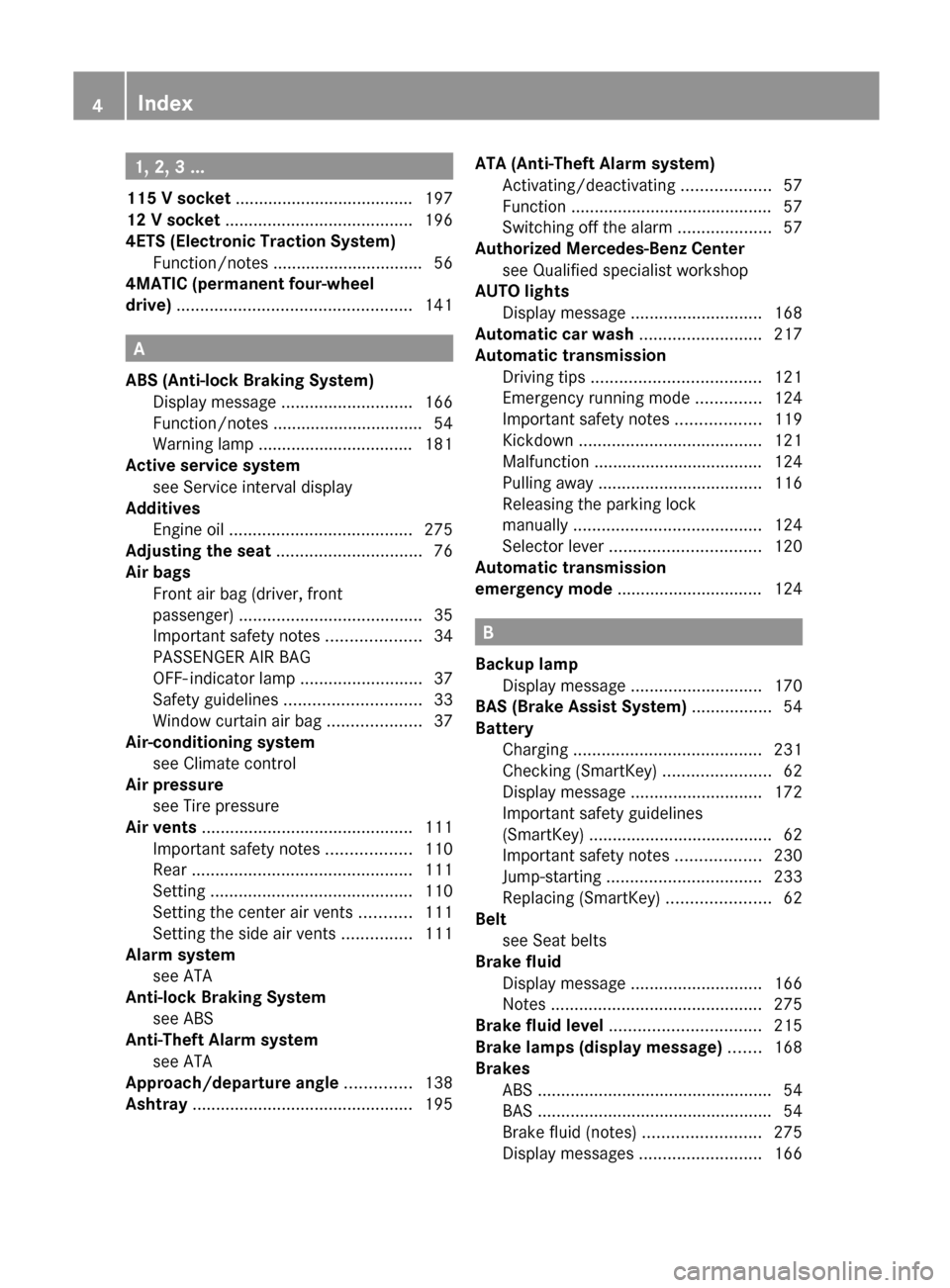
1, 2, 3 ...
115 V socket ...................................... 197
12 V socket
........................................ 196
4ETS (Electronic Traction System) Function/notes ................................ 56
4MATIC (permanent four-wheel
drive) .................................................. 141A
ABS (Anti-lock Braking System) Display message ............................ 166
Function/notes
................................ 54
Warning lamp ................................. 181
Active service system
see Service interval display
Additives
Engine oil ....................................... 275
Adjusting the seat ............................... 76
Air bags Front air bag (driver, front
passenger) ....................................... 35
Important safety notes .................... 34
PASSENGER AIR BAG
OFF- indicator lamp .......................... 37
Safety guidelines ............................. 33
Window curtain air bag ....................37
Air-conditioning system
see Climate control
Air pressure
see Tire pressure
Air vents ............................................. 111
Important safety notes .................. 110
Rear ............................................... 111
Setting ........................................... 110
Setting the center air vents ...........111
Setting the side air vents ............... 111
Alarm system
see ATA
Anti-lock Braking System
see ABS
Anti-Theft Alarm system
see ATA
Approach/departure angle ..............138
Ashtray ............................................... 195ATA (Anti-Theft Alarm system)
Activating/deactivating
...................57
Function ........................................... 57
Switching off the alarm .................... 57
Authorized Mercedes-Benz Center
see Qualified specialist workshop
AUTO lights
Display message ............................ 168
Automatic car wash .......................... 217
Automatic transmission Driving tips .................................... 121
Emergency running mode ..............124
Important safety notes .................. 119
Kickdown ....................................... 121
Malfunction .................................... 124
Pulling away ................................... 116
Releasing the parking lock
manually ........................................ 124
Selector lever ................................ 120
Automatic transmission
emergency mode ............................... 124 B
Backup lamp Display message
............................ 170
BAS (Brake Assist System)
.................54
Battery Charging ........................................ 231
Checking (SmartKey) ....................... 62
Display message ............................ 172
Important safety guidelines
(SmartKey) ....................................... 62
Important safety notes .................. 230
Jump-starting ................................. 233
Replacing (SmartKey) ...................... 62
Belt
see Seat belts
Brake fluid
Display message ............................ 166
Notes ............................................. 275
Brake fluid level ................................ 215
Brake lamps (display message) .......168
Brakes ABS .................................................. 54
BAS .................................................. 54
Brake fluid (notes) .........................275
Display messages ..........................1664
Index
Page 8 of 284
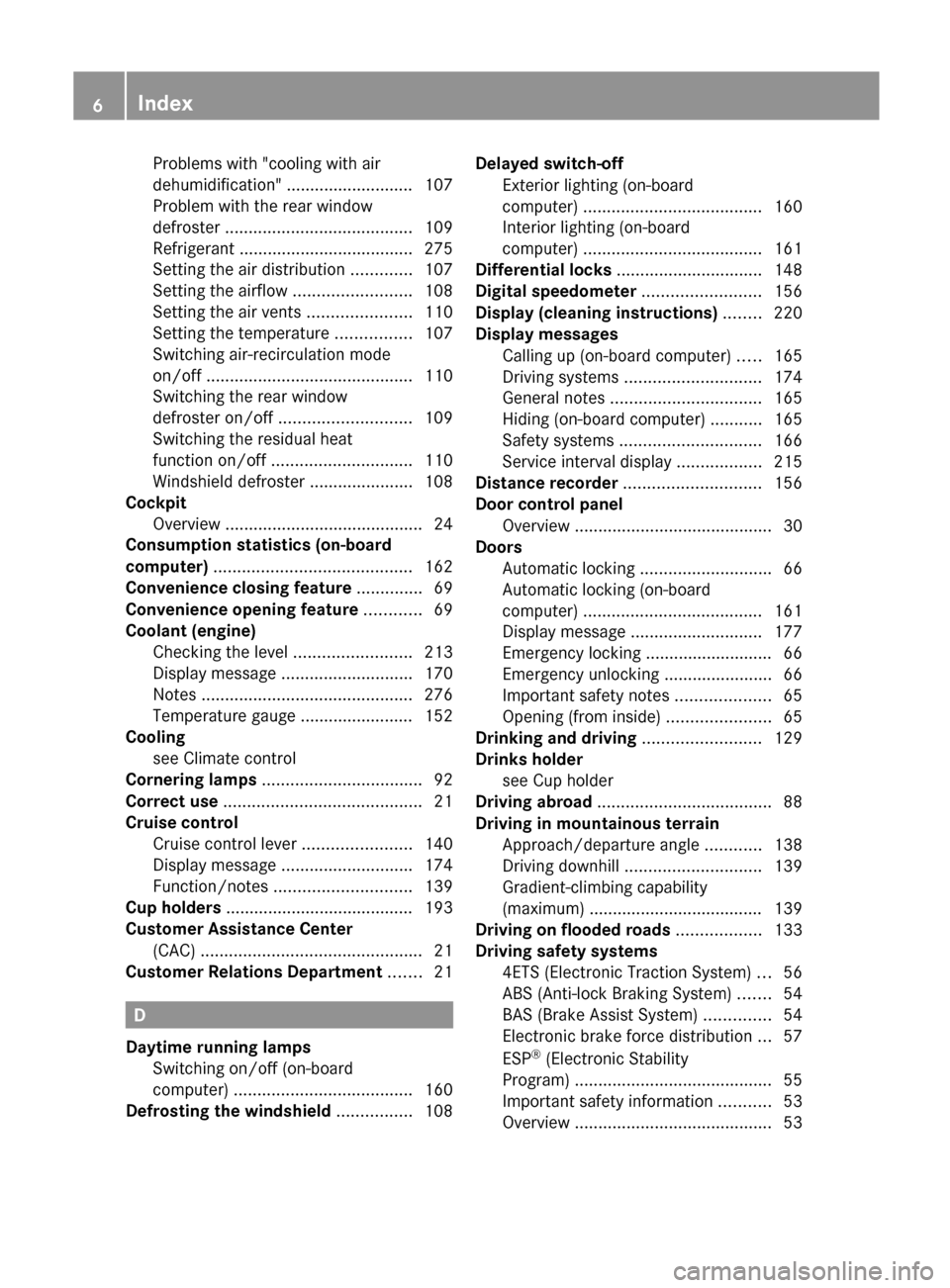
Problems with "cooling with air
dehumidification"
...........................
107
Problem with the rear window
defroster ........................................ 109
Refrigerant ..................................... 275
Setting the air distribution .............107
Setting the airflow ......................... 108
Setting the air vents ......................110
Setting the temperature ................ 107
Switching air-recirculation mode
on/off ............................................ 110
Switching the rear window
defroster on/off ............................ 109
Switching the residual heat
function on/off .............................. 110
Windshield defroster ......................108
Cockpit
Overview .......................................... 24
Consumption statistics (on-board
computer) .......................................... 162
Convenience closing feature ..............69
Convenience opening feature ............69
Coolant (engine) Checking the level ......................... 213
Display message ............................ 170
Notes ............................................. 276
Temperature gauge ........................ 152
Cooling
see Climate control
Cornering lamps .................................. 92
Correct use .......................................... 21
Cruise control Cruise control lever .......................140
Display message ............................ 174
Function/notes ............................. 139
Cup holders ........................................ 193
Customer Assistance Center
(CAC) ............................................... 21
Customer Relations Department .......21 D
Daytime running lamps Switching on/off (on-board
computer) ...................................... 160
Defrosting the windshield ................108Delayed switch-off
Exterior lighting (on-board
computer) ...................................... 160
Interior lighting (on-board
computer) ...................................... 161
Differential locks ............................... 148
Digital speedometer .........................156
Display (cleaning instructions) ........220
Display messages Calling up (on-board computer)
.....165
Driving systems ............................. 174
General notes ................................ 165
Hiding (on-board computer) ........... 165
Safety systems .............................. 166
Service interval display .................. 215
Distance recorder ............................. 156
Door control panel Overview .......................................... 30
Doors
Automatic locking ............................ 66
Automatic locking (on-board
computer) ...................................... 161
Display message ............................ 177
Emergency locking ........................... 66
Emergency unlocking .......................66
Important safety notes .................... 65
Opening (from inside) ......................65
Drinking and driving .........................129
Drinks holder see Cup holder
Driving abroad ..................................... 88
Driving in mountainous terrain Approach/departure angle ............ 138
Driving downhill ............................. 139
Gradient-climbing capability
(maximum) ..................................... 139
Driving on flooded roads ..................133
Driving safety systems 4ETS (Electronic Traction System) ...56
ABS (Anti-lock Braking System) ....... 54
BAS (Brake Assist System) ..............54
Electronic brake force distribution ... 57
ESP ®
(Electronic Stability
Program) .......................................... 55
Important safety information ........... 53
Overview .......................................... 536
Index
Page 9 of 284
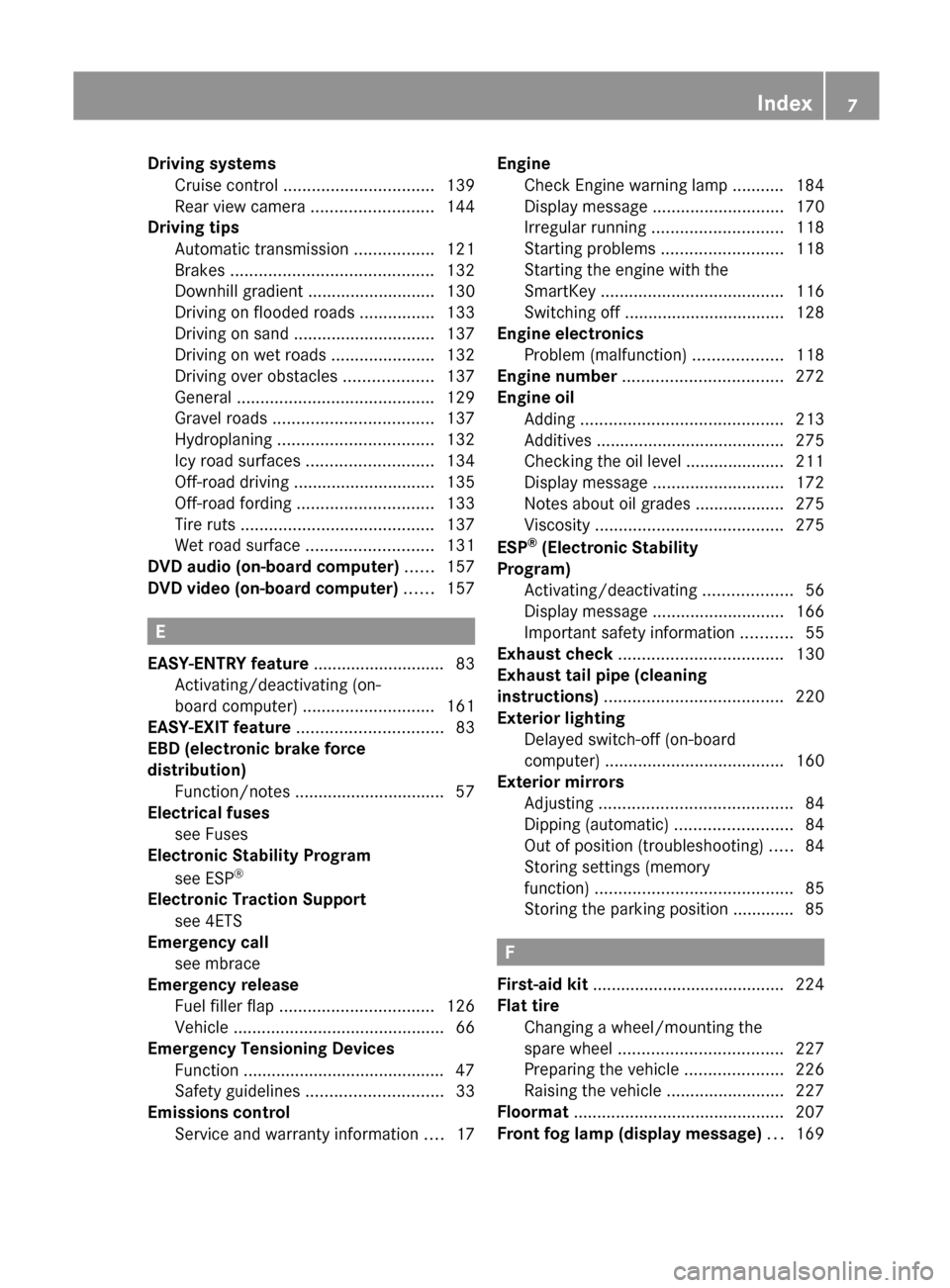
Driving systems
Cruise control ................................ 139
Rear view camera .......................... 144
Driving tips
Automatic transmission
.................121
Brakes ........................................... 132
Downhill gradient ........................... 130
Driving on flooded roads ................133
Driving on sand .............................. 137
Driving on wet roads ...................... 132
Driving over obstacles ................... 137
General .......................................... 129
Gravel roads .................................. 137
Hydroplaning ................................. 132
Icy road surfaces ........................... 134
Off-road driving .............................. 135
Off-road fording ............................. 133
Tire ruts ......................................... 137
Wet road surface ........................... 131
DVD audio (on-board computer) ...... 157
DVD video (on-board computer) ......157 E
EASY-ENTRY feature ............................ 83
Activating/deactivating (on-
board computer) ............................ 161
EASY-EXIT feature
............................... 83
EBD (electronic brake force
distribution)
Function/notes ................................ 57
Electrical fuses
see Fuses
Electronic Stability Program
see ESP ®
Electronic Traction Support
see 4ETS
Emergency call
see mbrace
Emergency release
Fuel filler flap ................................. 126
Vehicle ............................................. 66
Emergency Tensioning Devices
Function ........................................... 47
Safety guidelines ............................. 33
Emissions control
Service and warranty information .... 17Engine
Check Engine warning lamp ........... 184
Display message
............................ 170
Irregular running ............................ 118
Starting problems .......................... 118
Starting the engine with the
SmartKey ....................................... 116
Switching off .................................. 128
Engine electronics
Problem (malfunction) ...................118
Engine number .................................. 272
Engine oil Adding ........................................... 213
Additives ........................................ 275
Checking the oil level ..................... 211
Display message ............................ 172
Notes about oil grades ................... 275
Viscosity ........................................ 275
ESP ®
(Electronic Stability
Program) Activating/deactivating ................... 56
Display message ............................ 166
Important safety information ........... 55
Exhaust check ................................... 130
Exhaust tail pipe (cleaning
instructions) ...................................... 220
Exterior lighting Delayed switch-off (on-board
computer) ...................................... 160
Exterior mirrors
Adjusting ......................................... 84
Dipping (automatic) .........................84
Out of position (troubleshooting) .....84
Storing settings (memory
function) .......................................... 85
Storing the parking position ............. 85 F
First-aid kit ......................................... 224
Flat tire Changing a wheel/mounting the
spare wheel
................................... 227
Preparing the vehicle .....................226
Raising the vehicle ......................... 227
Floormat ............................................. 207
Front fog lamp (display message) ...169 Index
7
Page 34 of 284

Useful information
i This Operator's Manual describes all
models and all standard and optional
equipment of your vehicle available at the
time of publication of the Operator's
Manual. Country-specific differences are
possible. Please
note that your vehicle may
not be equipped with all features
described. This also applies to safety-
related systems and functions.
i Please read the information on qualified
specialist workshops (Y page 20). Occupant safety
Overview of occupant safety
In this section you will learn the most
important facts about the restraint system
components of the vehicle.
The restraint system consists of:
R seat belts
R child restraint systems
R LATCH-type (ISOFIX) child seat securing
system
Additional protection is provided by:
R SRS (Supplemental Restraint System)
R NECK-PRO head restraints
R air bag system components with:
-45
indicator lamp
- front-passenger seat with BabySmart™
automatic child recognition
The different air bag systems work
independently of each other. The protective
functions of the system work in conjunction
with each
other. Not all air bags are deployed
in an accident. G
WARNING
Modifications to or work improperly
conducted on restraint system components
or their wiring, as well as tampering with
interconnected electronic systems, can lead to
the restraint systems no longer functioning
as intended.
Air bags or Emergency Tensioning Devices
(ETDs), for example, could deploy
inadvertently or fail to deploy in accidents
although the deceleration threshold for air
bag deployment is exceeded. Therefore,
never modify the restraint systems. Do not
tamper with electronic components or their
software.
i See "Children in the vehicle"
(Y page 47) for further information on
infants and
children traveling in the vehicle
as well as on child restraint systems. SRS
(Supplemental Restraint System)
Introduction SRS reduces the risk of occupants coming
into contact with the vehicle's interior in the
event of an accident. It can also reduce the
effect of the forces to which occupants are
subjected during an accident.
SRS consists of:
R
the + SRS warning lamp
R air bags
R air bag control unit (with crash sensors)
R Emergency Tensioning Devices
R seat belt force limiters
SRS warning lamp SRS functions are checked regularly when
you switch on the ignition and when the
engine is running. Therefore, malfunctions
can be detected in good time.
The
+
SRS
warning lamp in the instrument
cluster lights up when the ignition is switched
on. It goes out no later than a few seconds
after the engine is started. 32
Occupant safety
Safety
Page 35 of 284
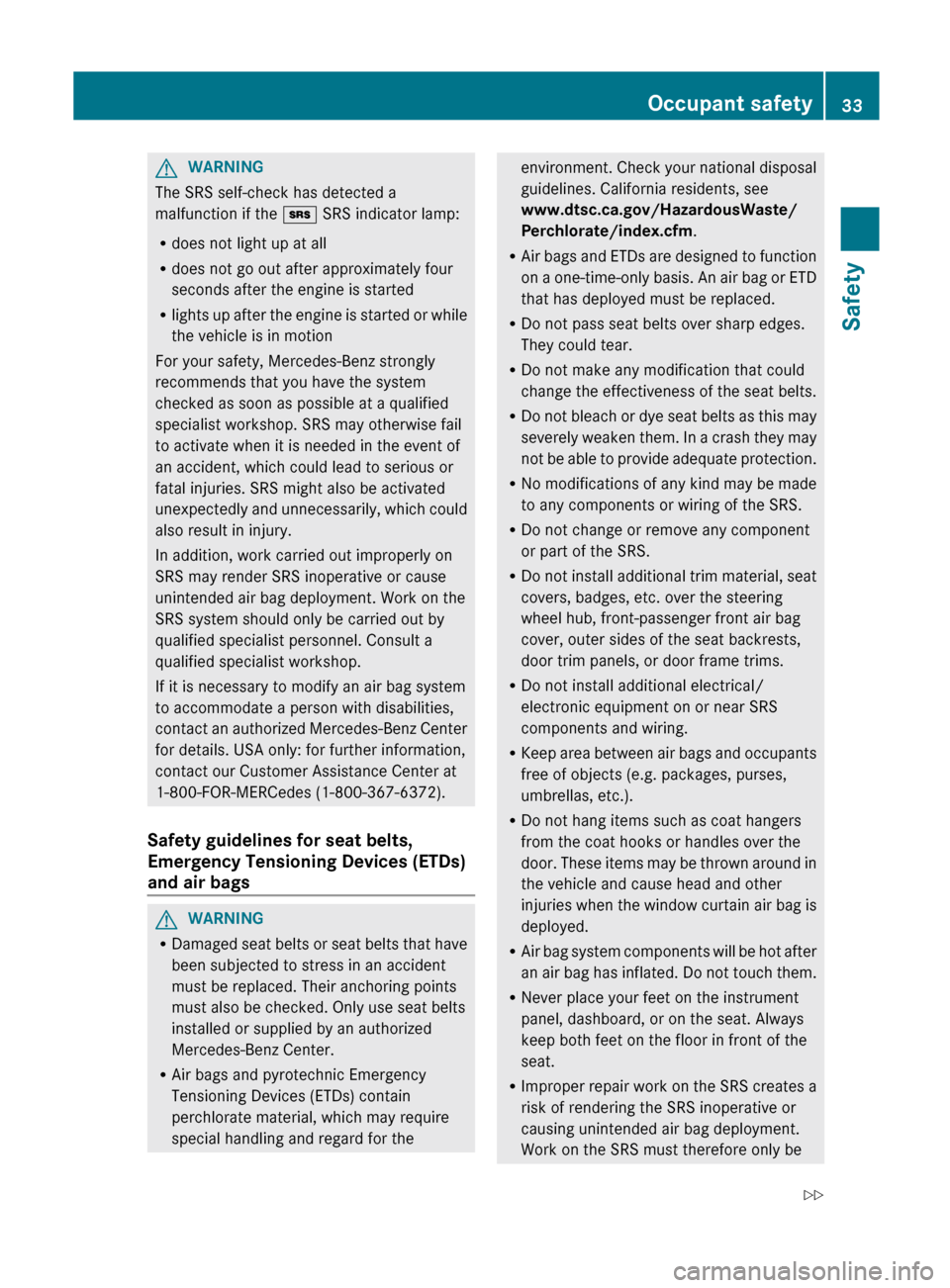
G
WARNING
The SRS self-check has detected a
malfunction if the + SRS indicator lamp:
R does not light up at all
R does not go out after approximately four
seconds after the engine is started
R lights up
after the engine is started or while
the vehicle is in motion
For your safety, Mercedes-Benz strongly
recommends that you have the system
checked as soon as possible at a qualified
specialist workshop. SRS may otherwise fail
to activate when it is needed in the event of
an accident, which could lead to serious or
fatal injuries. SRS might also be activated
unexpectedly and unnecessarily, which could
also result in injury.
In addition, work carried out improperly on
SRS may render SRS inoperative or cause
unintended air bag deployment. Work on the
SRS system should only be carried out by
qualified specialist personnel. Consult a
qualified specialist workshop.
If it is necessary to modify an air bag system
to accommodate a person with disabilities,
contact an authorized Mercedes-Benz Center
for details. USA only: for further information,
contact our Customer Assistance Center at
1-800-FOR-MERCedes (1-800-367-6372).
Safety guidelines for seat belts,
Emergency Tensioning Devices (ETDs)
and air bags G
WARNING
R Damaged seat
belts or seat belts that have
been subjected to stress in an accident
must be replaced. Their anchoring points
must also be checked. Only use seat belts
installed or supplied by an authorized
Mercedes-Benz Center.
R Air bags and pyrotechnic Emergency
Tensioning Devices (ETDs) contain
perchlorate material, which may require
special handling and regard for the environment.
Check your national disposal
guidelines. California residents, see
www.dtsc.ca.gov/HazardousWaste/
Perchlorate/index.cfm.
R Air bags
and ETDs are designed to function
on a one-time-only basis. An air bag or ETD
that has deployed must be replaced.
R Do not pass seat belts over sharp edges.
They could tear.
R Do not make any modification that could
change the effectiveness of the seat belts.
R Do not bleach or dye seat belts as this may
severely weaken them. In a crash they may
not be able to provide adequate protection.
R No modifications of any kind may be made
to any components or wiring of the SRS.
R Do not change or remove any component
or part of the SRS.
R Do not install additional trim material, seat
covers, badges, etc. over the steering
wheel hub, front-passenger front air bag
cover, outer sides of the seat backrests,
door trim panels, or door frame trims.
R Do not install additional electrical/
electronic equipment on or near SRS
components and wiring.
R Keep area between air bags and occupants
free of objects (e.g. packages, purses,
umbrellas, etc.).
R Do not hang items such as coat hangers
from the coat hooks or handles over the
door. These items may be thrown around in
the vehicle and cause head and other
injuries when the window curtain air bag is
deployed.
R Air bag system components will be hot after
an air bag has inflated. Do not touch them.
R Never place your feet on the instrument
panel, dashboard, or on the seat. Always
keep both feet on the floor in front of the
seat.
R Improper repair work on the SRS creates a
risk of rendering the SRS inoperative or
causing unintended air bag deployment.
Work on the SRS must therefore only be Occupant safety
33
Safety
Z
Page 38 of 284

Driver's air bag
: deploys in front of the
steering wheel; front-passenger front air
bag ; deploys
in front of and above the glove
box.
They are deployed:
R in the event of certain frontal impacts
R if the system determines that air bag
deployment can offer additional protection
to that provided by the seat belt
R depending on whether the seat belt is being
used
R independently of other air bags in the
vehicle
If the vehicle overturns, the front air bags are
generally not deployed unless the system
detects high vehicle deceleration in a
longitudinal direction.
Your vehicle has an adaptive, two-stage
driver's air bag. In the event of a collision, the
air bag control unit evaluates the vehicle
deceleration. When the first deployment
threshold is reached, the front air bag is filled
with enough propellant gas to reduce the risk
of injuries. The front air bag is fully deployed
if a second deployment threshold is exceeded
within a few milliseconds.
The front air bags will not deploy in impacts
with vehicle deceleration or acceleration
rates which do not exceed the system’s
preset deployment thresholds for vehicle
deceleration or acceleration. You will then be
protected by the fastened seat belt. The front-passenger front air bag will only
deploy if:
R
the front-passenger seat is occupied.
R the 45 indicator
lamp in the center
console is not lit (Y page 37).
R the impact exceeds a preset deployment
threshold.
The front-passenger air bag is automatically
activated and deactivated. Both driver and
passenger should always check whether the
front-passenger air bag is activated or
deactivated.
The deployment of the driver's air bag does
not mean that the front-passenger air bag will
also deploy. If the system recognizes that the
front-passenger seat is empty, the front-
passenger air bag does not deploy even if the
impact fulfills the criteria and the driver's air
bag has deployed.
If the front-passenger seat is recognized as
occupied, the 45 indicator lamp lights
up for approximately six seconds if
R you turn the SmartKey to position 1 or 2 in
the ignition lock.
R the engine is running and then you switch
it off.
This indicates the operational readiness of
the front-passenger air bag.
Note that objects placed on the front-
passenger seat may cause the system to
recognize the seat as occupied. This can
result in the deployment of the front-
passenger air bag if the impact fulfills the
specified criteria. If the 45 indicator
lamp is lit up, the front-passenger air bag is
deactivated and will not deploy should the
situation arise. If indicator lamp 45 is
not lit up, the front-passenger air bag is
activated and will deploy should the situation
arise. G
WARNING
Your vehicle is equipped with air bag
technology which disables the front- 36
Occupant safety
Safety
Page 66 of 284
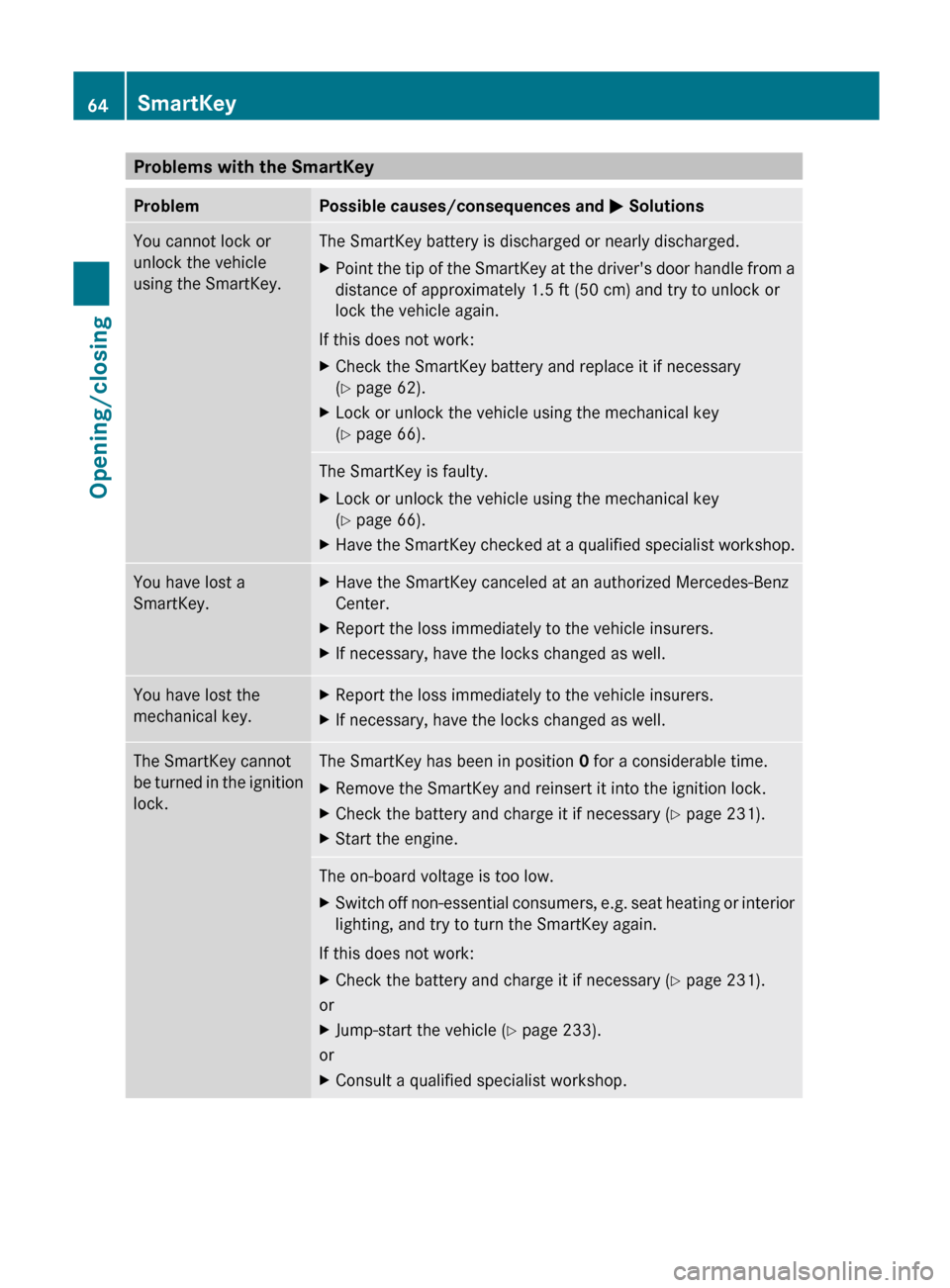
Problems with the SmartKey
Problem Possible causes/consequences and
M Solutions
You cannot lock or
unlock the vehicle
using the SmartKey. The SmartKey battery is discharged or nearly discharged.
X
Point the tip of the SmartKey at the driver's door handle from a
distance of approximately 1.5 ft (50 cm) and try to unlock or
lock the vehicle again.
If this does not work:
X Check the SmartKey battery and replace it if necessary
(Y page 62).
X Lock or unlock the vehicle using the mechanical key
(Y page 66). The SmartKey is faulty.
X
Lock or unlock the vehicle using the mechanical key
( Y page 66).
X Have the SmartKey checked at a qualified specialist workshop. You have lost a
SmartKey. X
Have the SmartKey canceled at an authorized Mercedes-Benz
Center.
X Report the loss immediately to the vehicle insurers.
X If necessary, have the locks changed as well. You have lost the
mechanical key. X
Report the loss immediately to the vehicle insurers.
X If necessary, have the locks changed as well. The SmartKey cannot
be
turned
in the ignition
lock. The SmartKey has been in position
0
for a considerable time.
X Remove the SmartKey and reinsert it into the ignition lock.
X Check the battery and charge it if necessary ( Y page 231).
X Start the engine. The on-board voltage is too low.
X
Switch off non-essential consumers, e.g. seat heating or interior
lighting, and try to turn the SmartKey again.
If this does not work:
X Check the battery and charge it if necessary ( Y page 231).
or
X Jump-start the vehicle (Y page 233).
or
X Consult a qualified specialist workshop.64
SmartKey
Opening/closing
Page 94 of 284

X
To switch on manually: turn the
SmartKey to position 2 in the ignition lock
or start the engine.
X Briefly press button : of the headlamp
cleaning system.
The headlamps are cleaned with a high-
pressure water jet. Cornering light function
The cornering light function improves the
illumination of the road over a wide angle in
the direction
you are turning, enabling better
visibility in tight bends, for example. It can
only be activated if the low-beam headlamps
are switched on and the fog lamp is switched
off.
Active: if you are driving at speeds below
25 mph(40 km/h) and switch on the turn
signals and turn the steering wheel.
Not active: if you are driving at speeds above
25 mph(40 km/h) or switch off the turn signal
and turn the steering wheel to the straight-
ahead position.
The cornering lamp may remain lit for a short
time. Headlamps and indicator lamps
fogged up on the inside
The headlamps
and the indicator lamps in the
exterior mirrors may fog up on the inside if
there is high atmospheric humidity. X
Drive with the headlamps switched on.
The level of moisture diminishes,
depending on
the length of the journey and
the weather conditions (humidity and
temperature).
If the level of moisture does not diminish:
X Have the headlamps checked at a qualified
specialist workshop. Interior lighting
Overview of interior lighting
Front overhead control panel
:
t To switch the cargo compartment
lamp/rear interior lighting on/off
; p Switches the right-hand reading
lamp on/off
= Rocker switch (to control the interior
lighting)
? p Switches the left-hand reading lamp
on/off 92
Interior lighting
Lights and windshield wipers
Page 108 of 284

otherwise fog up as, in air-recirculation
mode,
no
fresh air is drawn into the vehicle.
R Use the residual heat function if you want
to heat or ventilate the vehicle interior
when the ignition is switched off. The
"residual heat" function can only be
activated or deactivated with the ignition
switched off.
R At very low temperatures, the rear window
defroster is only switched on once the
vehicle interior has warmed up. Activating/deactivating climate
control
Important information G
WARNING
When the climate control system is
deactivated, the outside air supply and
circulation are also deactivated. Only choose
this setting for a short time. Otherwise the
windows could
fog up, impairing visibility and
endangering you and others.
i Switch on climate control primarily using
the à button ( Y page 107).
Activating/deactivating X
Turn the SmartKey to position 2 in the
ignition lock.
X To switch on:
turn
control : clockwise to
the desired position (except position 0)
(Y page 105).
X The previously selected settings come into
effect again.
X To switch off: turn control : counter-
clockwise to position 0(Y page 105). Activating/deactivating the cooling
with air dehumidification function
Important information The cooling with air dehumidification function
is only available when the engine is running.
The air inside the vehicle is cooled and
dehumidified according to the temperature
selected.
G
WARNING
If you switch off the cooling function, the
vehicle will not be cooled when weather
conditions are
warm. The windows can fog up
more quickly. Window fogging may impair
visibility and endanger you and others.
Condensation may drip from the underside of
the vehicle when it is in cooling mode. This is
normal and not a sign that there is a
malfunction.
i The cooling with air dehumidification
function uses refrigerant R134a. This
coolant does not contain
chlorofluorocarbons, and therefore does
not damage the ozone layer.
Activating/deactivating !
If the cooling with air dehumidification
does not switch on, it is possible that the
climate control system has lost coolant.
Have the cooling with air dehumidification
checked at
a qualified specialist workshop.
X To activate: press the Á button.
The indicator
lamp in the Á button lights
up.
X To switch off: press the Á button.
The indicator
lamp in the Á button goes
out. The cooling with air dehumidification
function has a delayed switch-off feature. 106
Operating the climate control system
Climate control
Page 117 of 284

on the brake pedal, the vehicle could
accelerate quickly forward or in reverse. You
could lose control of the vehicle and hit
someone or something. Only shift into gear
when the engine is idling normally and when
your right foot is firmly on the brake pedal.
! Warm up the engine quickly. Do not use
the engine's full performance until it has
reached operating temperature.
Only shift the automatic transmission to
the desired
drive position when the vehicle
is stationary.
Where possible, avoid spinning the drive
wheels when pulling away on slippery
roads. You could otherwise damage the
drive train.
! Avoid high engine speeds when the
engine is cold. The engine's service life
could otherwise be significantly shortened.
Do not use the engine's full performance
until it has reached operating temperature. SmartKey positions
g
To remove the SmartKey
1 Power supply for some consumers, such
as the windshield wipers
2 Ignition (power supply for all consumers)
and drive position
3 To start the engine i
You can only remove the SmartKey if:
R the SmartKey is in position
0 in the
ignition lock.
R the automatic transmission selector
lever is in P.
As soon
as the ignition is switched on, all the
indicator lamps in the instrument cluster light
up. If an indicator lamp does not go out after
the engine is started or if it lights up while the
vehicle is in motion, see ( Y page 180).
If the SmartKey is in position 0 in the ignition
lock for an extended period of time, it can no
longer be turned in the ignition lock. The
steering is then locked. To unlock, remove the
SmartKey and reinsert it into the ignition lock.
The steering is locked when you remove the
SmartKey from the ignition lock.
X Remove the SmartKey when the engine is
switched off.
The starter battery could otherwise be
discharged.
If you cannot turn the SmartKey in the ignition
lock, the starter battery may not be charged
sufficiently.
X Check the starter battery and charge if
necessary ( Y page 231).
or
X Jump-start the vehicle (Y page 233). Starting the engine
Important safety notes G
WARNING
Inhalation
of exhaust gas is hazardous to your
health. All exhaust gas contains carbon
monoxide (CO), and inhaling it can cause
unconsciousness and possible death.
Do not
run the engine in confined areas (such
as a garage) which are not properly ventilated.
If you think that exhaust gas fumes are
entering the vehicle while driving, have the
cause determined and corrected
immediately. If you must drive under these Driving
115
Driving and parking
Z